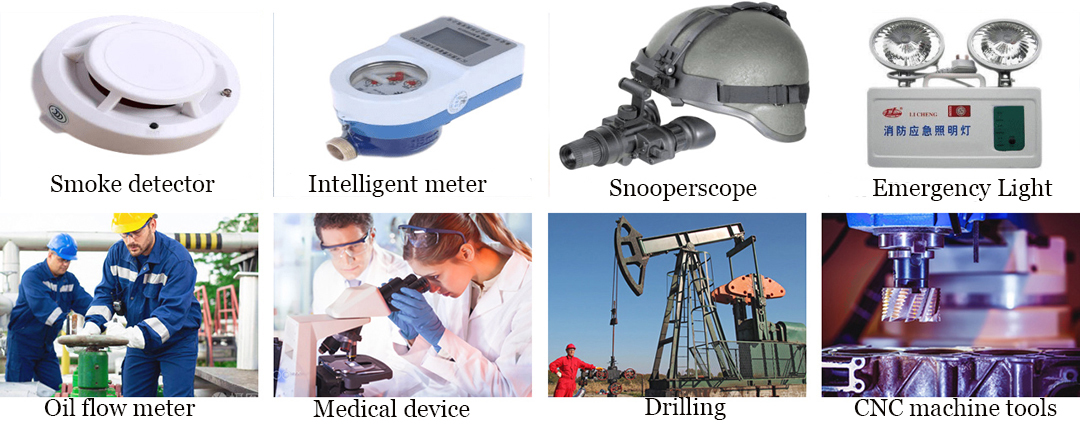high-temperature Li-SOCl₂ battery and high temperature battery features
High-temperature Li-SOCl₂ battery and high temperature battery features

The high-temperature lithium thionyl chloride battery (abbreviated as high-temperature Li-SOCl₂ battery) possesses a series of distinctive features that set it apart for use in specific fields. The following elaborates on its key unique attributes:
1. High Voltage and Stable Discharge Curve
High Voltage: The high-temperature Li-SOCl₂ battery boasts the highest discharge voltage among primary lithium batteries, with an open-circuit voltage of approximately 3.6V, significantly higher than many other battery types.
Stable Discharge Curve: Its discharge curve remains exceptionally flat until nearing the end of discharge (around 2.0V), where it experiences an abrupt change. This characteristic ensures stable output voltage throughout prolonged use.
2. High Specific Energy
The battery exhibits an exceptionally high specific energy, achieving an actual specific energy of 405Wh/kg or even higher. This translates to more stored energy per unit volume or weight, enabling extended device usage.
3. Wide Operating Temperature Range
With an extremely wide operating temperature range from -55°C to +200°C (special designs can reach even higher temperatures), the battery maintains stable performance across extreme conditions. This suits applications in oil extraction, geological exploration, aerospace, and other fields.
4. Long Storage Life
The high-temperature Li-SOCl₂ battery boasts a long storage life of over 10 years. This ensures that the battery retains its performance even after prolonged periods of inactivity, providing reliable power backup.
5. Safety and Reliability
Despite its high energy density and wide operating temperature range, the battery ensures safety and reliability through specialized designs and manufacturing processes. It maintains stable operation in high-temperature, vibration, and shock environments.
6. High Current Output Capability
With a maximum capacity of up to 40 Ampere-hours (Ah), a maximum rated current of 4 Amperes (A), and a peak current of 7A, the battery accommodates devices requiring substantial current draw.
7. Adaptability to Special Application Fields
Its unique performance characteristics make the high-temperature Li-SOCl₂ battery ideally suited for applications in oil extraction, geological exploration, aerospace, military equipment, and other fields where devices operate under harsh conditions of high temperature, pressure, and vibration.
In summary, the high-temperature lithium thionyl chloride battery stands out due to its high voltage, high specific energy, wide operating temperature range, long storage life, safety and reliability, high current output capability, and adaptability to specialized applications.
The scope of application for high-temperature batteries is broad, and their characteristics are pronounced, mainly manifested in the following aspects:
Scope of Application
High-temperature batteries are primarily used in situations requiring high temperature performance, including but not limited to:
Aerospace Industry: Spacecraft experience extreme temperature variations in space, and high-temperature batteries can meet these rigorous conditions to ensure the normal operation of spacecraft.
Military Equipment: Military devices often need to operate in various complex environments, including high-temperature ones. High-temperature batteries, with their high safety and reliability, make them an ideal choice for military equipment.
Electric Vehicles: In high-temperature environments, the performance of traditional batteries may be affected, while high-temperature batteries can maintain stable performance, enhancing the endurance of electric vehicles.
Industrial Control: In some industrial control systems that require continuous high-temperature operation, high-temperature batteries can provide stable power support.
Portable Power Banks: For portable power banks that need to be used in high-temperature environments, high-temperature batteries can ensure safe and reliable power supply.

Characteristics
High Safety: High-temperature batteries employ solid electrolytes instead of liquid electrolytes, significantly reducing the risk of thermal runaway and enhancing battery safety.
Excellent Temperature Adaptability: They can operate normally in high-temperature environments with stable performance, unaffected by external temperature changes.
Long Cycle Life: The absence of decomposition during charging and discharging extends the battery's cycle life.
High Power Density: With a specific energy reaching a certain level (e.g., 150Wh/kg), they can provide powerful dynamic support.
Large Capacity: The battery cells boast high energy density and volumetric energy density, meeting the needs for prolonged and intensive use.
Economy and Environmental Friendliness: High-temperature batteries effectively reduce loading costs by decreasing the reliance on air conditioning or mechanical cooling systems. Furthermore, their high safety and reliability can diminish maintenance and replacement costs due to battery failures. Additionally, the research and application of high-temperature batteries contribute to environmental protection and sustainable development.
In summary, high-temperature batteries, with their high safety, excellent temperature adaptability, long cycle life, high power density, and large capacity, have found widespread applications in the aerospace industry, military equipment, electric vehicles, industrial control, and portable power banks. As technology advances and research deepens, the performance of high-temperature batteries will continue to improve, and their scope of application will further expand.





